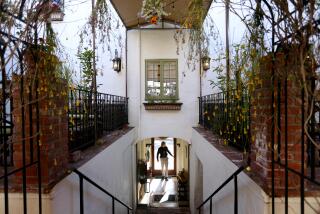New Jersey’s Victorian Time Warp
- Share via
CAPE MAY, N.J. — Cape May, a seaside resort even in pre-Revolutionary days, is caught in a time warp.
Sitting at the southern tip of New Jersey, where Delaware Bay meets the Atlantic, it may be the Victorian capital of America--with more than 600 classic Victorian homes, one of the largest collections of preserved and restored 19th-Century structures in the country.
Much of the credit for the Victorians’ continued presence goes to Carolyn Pitts, the National Park Service’s architectural historian and a woman who has been called “a guerrilla preservationist” by Time magazine.
“We call Carolyn Pitts the Joan of Ark of Cape May,” said Barbara Beitel, director of the Chamber of Commerce in this town of 5,000. “More than anyone, she saved the unique character of Cape May.”
After the town was devastated in 1962 by a storm that seriously damaged many of the Victorians, businessmen, civic leaders and developers decided to level the boarded-up old buildings and replace them with modern structures.
Pitts was hired by the federal Department of Housing and Urban Development to conduct a study before any of the buildings could be razed.
“It was the first urban renewal grant ever for preservation,” recalled Pitts, 67, now based in Washington. “It turned out Cape May wasn’t just a town with a bunch of 19th-Century frame buildings. It’s an architectural gold mine with 50 different styles of Victorians” erected between 1850 and the turn of the century by wealthy Easterners who vacationed here.
The buildings were spared from the wrecker’s ball, and for the next 12 years Pitts led a team of architectural historians that catalogued the structures.
As a result of Pitts’ efforts, the town is filled with restored Queen Anne cottages, stick-style houses, octagon homes, Gothic revival and American graphic structures, homes with crowned dormers, ornate verandas, mansard and multigabled roofs, lean towers, elaborate chimneys and rocking chairs on seemingly every porch.
The proud owners of high-ceilinged private homes furnish them with Victorian rugs, chairs, dressers and tables, lace-curtained windows, gilt lamps, huge bookcases and beveled and stained glass. A theater company produces 19th-Century plays, and the town also presents Victorian fashion shows, formal Victorian balls and a 10-day “Victorian week.”
Eighty of the Victorians have been converted into bed-and-breakfast and guest houses--the largest assemblage of bed-and-breakfast houses in the United States. Others have become boutiques and restaurants.
In recent years, the value of the old frame houses has skyrocketed.
“Cape May before restoration was an economic disaster. The terrible storm of 1962 only compounded matters,” Pitts said. “It was a relic of the past rotting away at the core, with its clutter of old buildings in various stages of disrepair.”
In the last half of the 19th Century, the town was the watering hole of the rich and famous.
Abraham and Mary Todd Lincoln came here to relax in 1849 when he was an Illinois congressman, and five other Presidents--James Buchanan, Benjamin Harrison, Franklin Pierce, Chester A. Arthur and Ulysses S. Grant--vacationed here while in the White House. While Harrison was in his summer White House, the Congress Hall Hotel in Cape May, John Phillip Sousa stopped by and led his band playing “Congress Hall,” a march he composed to salute the President’s visit.
Because of her success at Cape May, Pitts was hired in 1974 as the Park Service’s architectural historian, the job she has held ever since. She has personally selected 200 of the 2,000 national historic landmarks, including the Chrysler Building in New York.
“It’s the best job in the Park Service,” she said. “I run around the country looking for significant buildings and historic districts to save and set aside.”
She added, “Today Cape May is the best-preserved 19th-Century seaside resort in America. It is a prime example of how preservation helps build a very sound economic base. It put an end to that whole business about preservationists impeding progress, which is a lot of baloney.”
More to Read
Sign up for Essential California
The most important California stories and recommendations in your inbox every morning.
You may occasionally receive promotional content from the Los Angeles Times.










